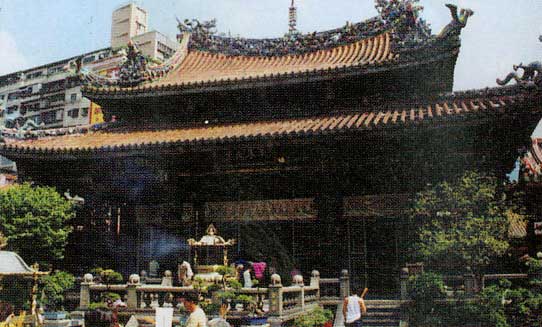 Longshan Temple, Mengjia
Longshan Temple, Mengjia Established in 1738, Longshan Temple was once the religious, municipal and self-defense center of the Mengjia area. Dedicated to the worship of the Buddhist goddess Avalokiteshvara (Guanshiyin), the temple became established as the spiritual center of immigrants from the Jinjiang, Nan'an and Hui'an districts of Quanzhou County, Fujian. Guild houses were also found here, contributing to the prosperity of the surrounding area.
Longshan Temple was renovated in 1920 under the direction of famous architect Wang Yi-shun. The octagonal ceiling in its front hall, the clock tower roof, and the circular ceiling in the main temple are exceptionally elegant. On August 19, 1985, Longshan Temple was designated Taipei City's fourth official historical site.
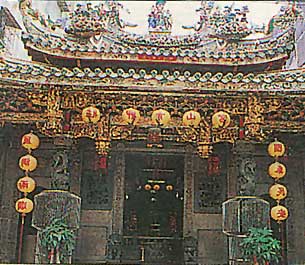 Qingshui Temple
Qingshui Temple
Qingshui Temple was built in 1787. Primarily honoring Master Qingshui, the guardian god of the people of Anxi County, Fujian Province, it was established as a branch of the Qingshui Temple of Anxi's Hunei Township by immigrants from that area.
The original temple burned down in 1853, when violence erupted over control of the Tamsui River harbor trade between people from Tong'an living in the Xia district of Mengjia and people from Jinjiang, Nan'an and Hui'an living in the Ding district. The event became known as the “Ding-Xia feud."
The temple was rebuilt in 1867. The rear hall has since been renovated a third time, but the main hall has retained the appearance of the first reconstruction. Along with Longshan and Qingshan temples, it is considered one of the “three great temples of Mengjia."
Qingshui Temple was originally complete in form, with a front hall, a main sanctuary in the middle, and a shrine to the goddess Matsu inside. Master Qingshui was the guardian god of the people of Anxi County, who opened up most of the surrounding farmlands in the Taipei Basin. Towards the end of the Qing dynasty, the French military invaded Tamsui during skirmishes between China and France. Receiving warning of the invasion, according to tradition the people of Taipei petitioned Master Qingshui for assistance. Taipei was left untouched by the conflict.
Qingshui Temple was used as a school during the Japanese colonial period (1895-1945), and was later established as the Number 2 Prefectural Middle School, the predecessor of today's Cheng Gong High School, thus playing a significant role in the history of education on Taiwan. On August 19, 1985, Qingshui Temple was designated the 10th historical site of Taipei City. In recent years, the temple's interior has undergone refurbishment in a bid to preserve this building of immense historical value.
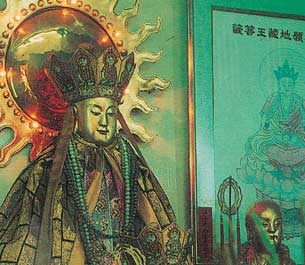 Dizang Temple
Dizang Temple
Dizang Temple of Mengjia, dedicated to the bodhisattva Kshitigarbha (Dizang), comforter of the underworld, also venerates the city's guardian deity god and folk deity, Master Tiandu. Built in 1760 and renovated in 1838, the temple still retains the single-structure design of the mid-Qing dynasty. It is rendered in a simple architectural style, with plain and straightforward sculptural ornaments. A shrine dedicated to the souls of the unknown departed is located to one side. On August 19, 1985, it was designated the 11th historical site of Taipei City.
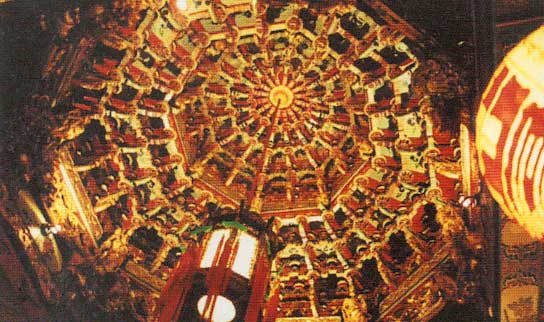 Qingshan Temple
Qingshan Temple
Mengjia's Qingshan Temple was dedicated to the worship of Zhang Gun, “Lord of Spiritual Peace," whose image was brought to Taiwan in 1854 from Qingshan Temple in Hui'an County by fishermen from that area.
Built in 1856 and completed in 1859, the temple features richly ornamented beams and rafters, as well as a front hall with an octagonal ceiling, all exhibiting exquisite workmanship. Remodeled in 1938, the front hall’s stone pillars and sculptures were built from remains of the Japanese-era Taiwan Provincial Shinto Temple at Yuanshan. On August 19, 1985, Qingshan Temple was designated Taipei City's 12th official historical site.
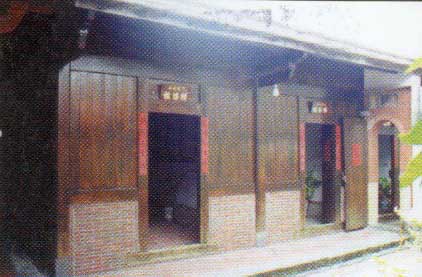 Xuehai Academy
Xuehai Academy
Xuehai Academy was established in 1837 following seven years of construction undertaken by Tamsui prefect Lou Yun and his successor Cao Jin. It was originally named Wen Jia Academy. (In the Minnan dialect, both Wen Jia and Mengjia – the city's name in that era – are pronounced Manka). Ten years later, the governor of Fujian and Zhejiang, Liu Yunke, changed the name to Xuehai Academy during a tour of the island. The academy enjoyed the distinction for a time as the highest institution of learning in the Tamsui-Taipei area. The imperial mandarin Chen Wei-ying, a brilliant and admired educator from the nearby town of Dalongdong (now part of west Taipei), once taught here and served as the academy's principal. While serving at Xuehai, he launched a charity donation drive to renovate the academy.
The Xuehai Academy featured a complete spatial design for an institution of learning. According to historical diagrams of Tamsui Prefecture, the layout included (in order) an outer wall, a main gate, a lecture hall, a shrine to the early Confucian scholar Zhu Xi, as well as left and right wings serving as classrooms. In recent years, the main gate was moved inward to accommodate the expansion of a roadway.
During the Japanese period the academy was used as a Japanese-language government office, a military barracks, and the site of the Laosong School. It was ultimately sold to the Gao clan to serve as their ancestral temple. Although the academy has undergone a series of renovations, it retains its original structure, and still serves as the Gao clan ancestral shrine. On August 19, 1985, Xuehai Academy was designated Taipei City's 13th official historical site.
Old Bajiazhuang (Hakkōchō) Post Office
![]() The post office was located in the Hakkōchō or Bajiading administrative district during the period of Japanese rule (in the Qing dynasty, it was called Bajiazhuang). Built in 1912, it was the first post office offering telegraph services. It was a detached two-story architecture constructed with reinforced bricks. Bajiazhuang was located on the eastern side of Bangka. In early times, it was inhabited by Tongan natives. During the regime of Emperor Xianfeng, due to the “armed conflicts between uptown and downtown” (Tíng-ē-kau-piànn), Tongan natives moved to Dadaocheng. During the early Japanese rule, a post office was established at Bajiazhuang. Now, Bajiazhuang Post Office tells us its of special historical and geographic significance.
The post office was located in the Hakkōchō or Bajiading administrative district during the period of Japanese rule (in the Qing dynasty, it was called Bajiazhuang). Built in 1912, it was the first post office offering telegraph services. It was a detached two-story architecture constructed with reinforced bricks. Bajiazhuang was located on the eastern side of Bangka. In early times, it was inhabited by Tongan natives. During the regime of Emperor Xianfeng, due to the “armed conflicts between uptown and downtown” (Tíng-ē-kau-piànn), Tongan natives moved to Dadaocheng. During the early Japanese rule, a post office was established at Bajiazhuang. Now, Bajiazhuang Post Office tells us its of special historical and geographic significance.
Taisugar Taipei warehouse
![]() In the past, Dali Street was called as Xiakanzhuang, where Yang Bei had established a sugar department during the Qing dynasty. People used oxen to drive sugar mills to press juice from sugarcane which was then cooked to make sugar. In 1909, the Japanese Kinoshita Shinsaburo and others established a new style sugar refinery at Xiakanzhuang in Bangka, called the “Taihoku Sugar Refinery.” Two years later, the factory was launched into operation. In 1915, it was merged with the Taiwan Sugar Refinery to become the “Taihoku Factory,” also known as the “Taihoku Sugar Factory,” being the only sugar refinery north of Taoyuan. During its peak, in addition to Xiakanzhuang and Jiana (today’s Shuangyuan), sugarcane was grown and harvested along the banks of Dahan River, Xindian River, Keelung River, etc. Later, due to the outbreak of the Pacific War, young men were enlisted in the army, and the material supplies for sugar manufacturing declined gradually. Finally, the refinery ceased to operate in 1942. Now, three of the old warehouses of the sugar refinery and the old platform with a length of 50 m and width of 20 m for mini trains to transport raw material remain intact. It tells the story of the close relation between the new style sugar refinery and rail transportation. The warehouses that make up the main architecture of this historic monument are laid with red bricks and feature arches, trapezoidal columns, and span frames. Now, it has been restructured into the Tangbu Cultural Park, serving as a base for the incubation of traditional arts.
In the past, Dali Street was called as Xiakanzhuang, where Yang Bei had established a sugar department during the Qing dynasty. People used oxen to drive sugar mills to press juice from sugarcane which was then cooked to make sugar. In 1909, the Japanese Kinoshita Shinsaburo and others established a new style sugar refinery at Xiakanzhuang in Bangka, called the “Taihoku Sugar Refinery.” Two years later, the factory was launched into operation. In 1915, it was merged with the Taiwan Sugar Refinery to become the “Taihoku Factory,” also known as the “Taihoku Sugar Factory,” being the only sugar refinery north of Taoyuan. During its peak, in addition to Xiakanzhuang and Jiana (today’s Shuangyuan), sugarcane was grown and harvested along the banks of Dahan River, Xindian River, Keelung River, etc. Later, due to the outbreak of the Pacific War, young men were enlisted in the army, and the material supplies for sugar manufacturing declined gradually. Finally, the refinery ceased to operate in 1942. Now, three of the old warehouses of the sugar refinery and the old platform with a length of 50 m and width of 20 m for mini trains to transport raw material remain intact. It tells the story of the close relation between the new style sugar refinery and rail transportation. The warehouses that make up the main architecture of this historic monument are laid with red bricks and feature arches, trapezoidal columns, and span frames. Now, it has been restructured into the Tangbu Cultural Park, serving as a base for the incubation of traditional arts.

![Taiwan.gov.tw [ open a new window]](/images/egov.png)
